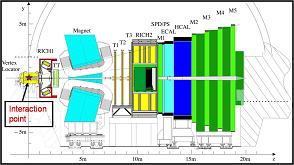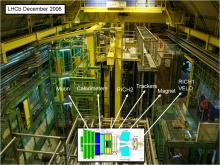
About the Project
- LHCb is a special purpose experiment being prepared for the CERN LHC collider.
- Its primary aim is to investigate the decays of B-particles (particles containing b-quarks) and so provide insight into the phenomenon of matter-antimatter asymmetries.
-
The collaboration comprises almost 1000 physicists and engineers from more than 65 institutes from all over the world.
A view of the LHCb at CERNCavendish HEP Group involvement
- The group collaborated closely with other UK institutes and CERN to build the Ring Imaging Cherenkov (RICH) detectors for LHCb and has significant responsibilities for their operation and for the related software. The RICH detectors enable different types of particles produced in the high energy proton-proton collisions to be distinguished, by detecting the Cerenkov radiation is emitted by charged particles when the particle speed exceeds the local speed of light.

- The Cambridge LHCb group is currently heavily involved in the analysis of the data from LHC:
- Searching for rare decays of B mesons. Those decays whose rate can be accurately predicted by the Standard Model of particle physics can be significantly enhanced by the existence of New Physics.
- Performing precise measurements of the parameters in the Standard model which characterise CP violation, i.e. the asymmetry between matter and antimatter. These studies are being pursued using decays of both B-mesons and D-mesons (involving the charm quark).
- The production of charm-anticharm bound states, including recently discovered "exotic" states.
- Measurement of W and Z boson production, which will provide new information about the internal structure of the proton.
- We are also actively involved in plans for an upgrade to the RICH photon detectors which will allow LHCb to run with higher intensity beams in the later phases of LHC.
